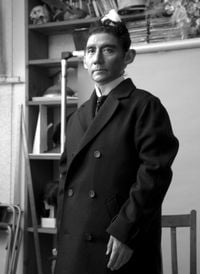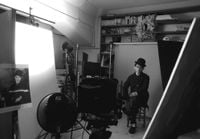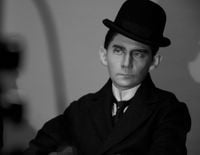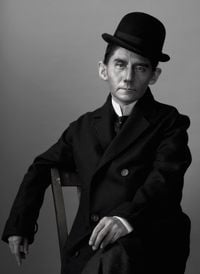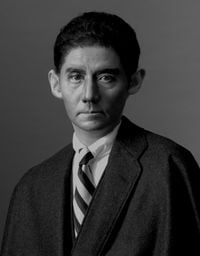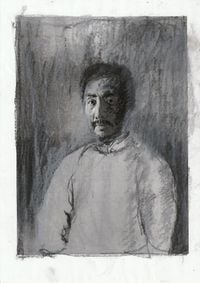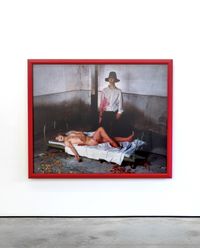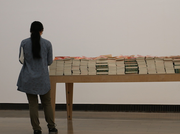Yasumasa Morimura (森村 泰昌) is known for his photographic self-portraits in which he either disguises himself as iconic figures from popular Western culture or uses digital tools to superimpose his own likeness into art-historical images. Using elaborate staging, props, costumes, make-up and prosthetics to embody well-known and usually female characters, Morimura not only challenges cultural and gender stereotypes and traditional notions of beauty, but also satirises celebrity, portraiture and idolisation.
Read MoreMorimura graduated from Kyoto City University of Arts with a Bachelor of Fine Arts in 1978 and started exhibiting in the early 1980s. His early hybrid self-portraits include the widely acclaimed Portrait (Van Gogh) (1985): a brightly coloured photograph of Morimura as Van Gogh with a bandaged ear, smoking a pipe.
Since then, he has constructed at least 300 self-portraits and has embodied art historical figures including the Mona Lisa (Mona Lisa in its Origin [1998]), Frida Kahlo (An Inner Dialogue with Frida Kahlo [Collar of Thorns] [2001]), all the characters of Velázquez's Las Meninas (1656) (In Praise of Velázquez: distinguished ones in confinement [2013]) and Pablo Picasso (A Requiem: Theatre of Creativity/Self-portrait as Pablo Picasso [2010]), as well as political figures such as Ché Guevara, Adolf Hitler and Chairman Mao. He also has convincingly impersonated numerous leading ladies from the silver screen, including Audrey Hepburn (Self-Portrait/After Audrey Hepburn 1 [1996]), Ingrid Bergman (Self-Portrait/After Ingrid Bergman [1996]), Marilyn Monroe (Self Portrait no. 56 [After Marilyn Monroe] [1995]), and Greta Garbo (Self-Portrait—After Greta Garbo 1 [1996]), demonstrating just how malleable identity can be.
Morimura's images also subtly subvert the male gaze. In Vermeer Study: Looking Back (Mirror) (2008), Morimura presents himself in place of The Girl with a Pearl Earring (1665), dressed as a gender-ambiguous model and—as the title suggests—using the opportunity to upset the standard narrative of the male artist observing a female subject. In Mona Lisa In Its Pregnancy (1998), Morimura not only refers to the famous smiling lady as gender-neutral, but creates a physical hybrid of the sexes by transposing his angular face and muscular arms onto a woman's naked torso with swollen breasts and a heavily pregnant stomach.
Despite being criticised as little more than humorous imitations, Morimura's images take complex historical Western references and retell them from an Asian perspective, often incorporating traditional Japanese detailing within the compositions. For example, in Portrait (Futago) (1988), Morimura presents himself as Manet's famous Olympia (1863), reclining nude on a traditional kimono next to a maneki-neko cat figure, and wearing a blonde version of a Geisha headdress. In doing so, he takes the mystery, desire and allure underlying the original and presents his own alternative, encouraging the viewer to reflect on the ideas of beauty and desire within the Western art canon and consciousness.
Morimura's work is held in both private and public art collections including the Museum of Contemporary Art Chicago, the J Paul Getty Museum in Los Angeles, and the Whitney Museum of American Art in New York.
Selected exhibitions include Criticism and the Lover, Mohly Gallery, Osaka (1989); Daughter of Art History, Sagacho Exhibit Space, Tokyo (1990); Options 44, Museum of Contemporary Art Chicago (1992); The Sickness Unto Beauty—Self-portrait as Actress, Yokohama Museum of Art (1996); Self-Portrait as Art History, Museum of Contemporary Art Tokyo (1998); Self-Portraits: An Inner Dialogue with Frida Kahlo, Luhring Augustine, New York (2001); My Life through a Looking-Glass, Reflex Amsterdam (2007); Theatre of the Self, The Andy Warhol Museum, Pittsburgh (2013); In the Room of Art History, Luhring Augustine, Brooklyn (2018); and Ego Obscura, Japan Society, New York (2018).
Morimura lives and works in Osaka.
Genista Jurgens | Ocula | 2018
